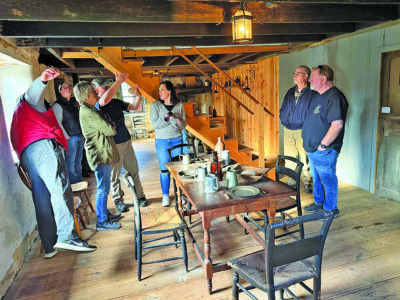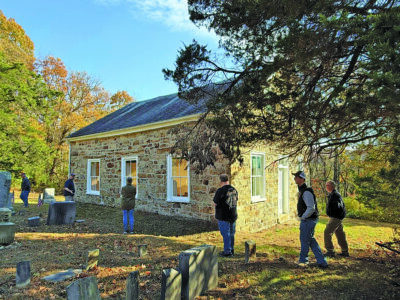Members tour Perry County landmarks
- Photo courtesy of JUNIATA COUNTY HISTORICAL SOCIETY This room in the basement of the Blue Ball Tavern at Little Buffalo State Park in Newport is set up to look like it was an 18th-century tavern.
- Photo courtesy of JUNIATA COUNTY HISTORICAL SOCIETY A view of a bedroom in the Cochran-Anspach House in Millerstown.
- Photo courtesy of JUNIATA COUNTY HISTORICAL SOCIETY Members of the historical societies from Juniata and Perry counties stand in the foyer as they tour the Cochran-Anspach House in Millerstown.
- Photo courtesy of JUNIATA COUNTY HISTORICAL SOCIETY A close-up of the table in the basement of the Blue Ball Tavern at Little Buffalo State Park in Newport.
- Photo courtesy of JUNIATA COUNTY HISTORICAL SOCIETY Members of the historical societies from Juniata and Perry counties are examining heavy rain damage remediation at the Ludolph Church in Elliottsburg.
- Photo courtesy of JUNIATA COUNTY HISTORICAL SOCIETY Jason Wilson, president of the Historical Society of Perry County, puts up the open flag at the Fetter House in Landisburg.
- Photo courtesy of JUNIATA COUNTY HISTORICAL SOCIETY The bedroom at the Fetter House in Landisburg showcases two chairs from the historic Centre Presbyterian Church in nearby Loysville.
- Photo courtesy of JUNIATA COUNTY HISTORICAL SOCIETY A view of the spiral staircase and all-seasons window in the Cochran-Anspach House in Millerstown.
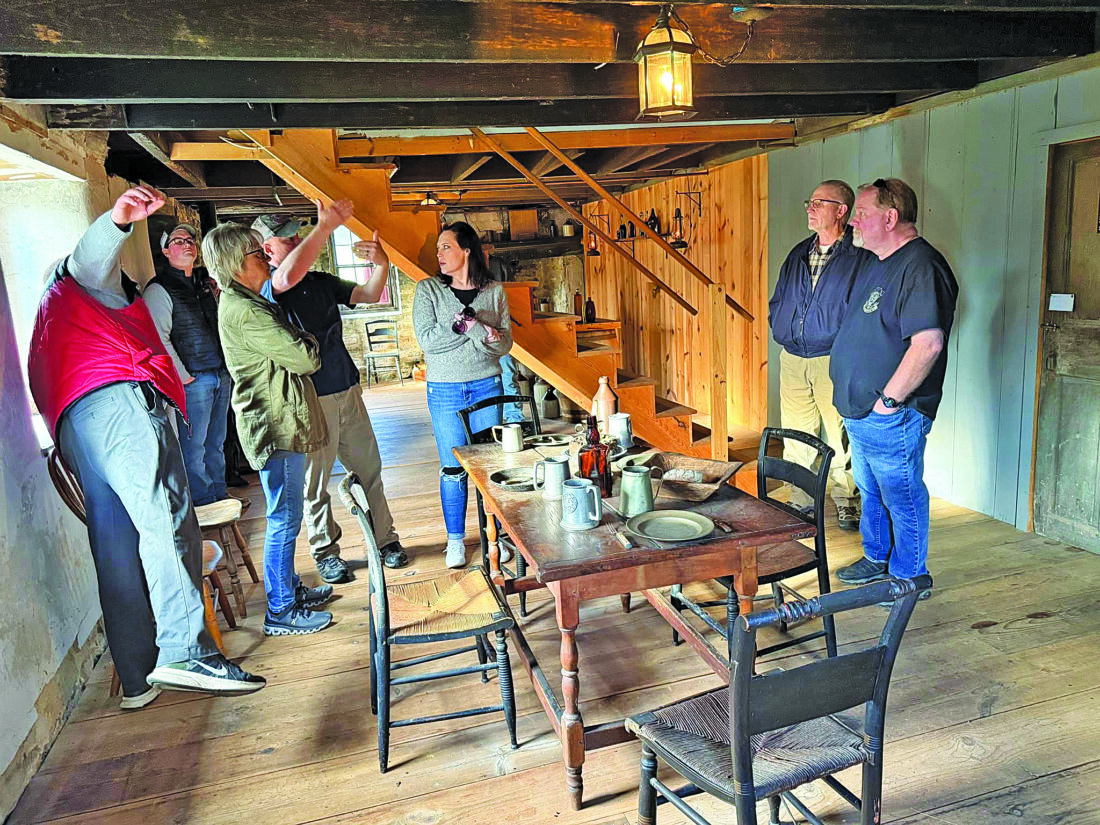
Photo courtesy of JUNIATA COUNTY HISTORICAL SOCIETY This room in the basement of the Blue Ball Tavern at Little Buffalo State Park in Newport is set up to look like it was an 18th-century tavern.
MIFFLINTOWN — As curator of the Tuscarora Academy Museum in Mifflin and president of the Juniata County Historical Society, Jessica Eaton Guyer certainly sees her share of fascinating historical pieces.
Recently, Guyer and a handful of other historical society members made the short drive to neighboring Perry County to take a walk back in time, touring some of the Historical Society of Perry County’s landmarks.
“We invited them to participate in our Indians and Ice Cream event this year and started talking about ways we could work together,” Guyer said of the popular fundraising event held at the Tuscarora Academy Museum during the summer months.
“That’s when the idea for a tour came around,” Guyer added. “We were able to share both struggles and success stories as small non-profits with such important missions.”
Pairing with Perry County for the Fourth Annual Indians and Ice Cream event seemed a match made in history heaven as that society had quite a wide array of prehistoric and Native American tools and weapons.

Photo courtesy of JUNIATA COUNTY HISTORICAL SOCIETY A view of a bedroom in the Cochran-Anspach House in Millerstown.
The Tuscarora Academy Museum also put some of its collection on display from Plains tribes c. 1890 to 1900, Guyer said.
Still, the expanded array of artifacts gave visitors an archaeological thrill.
Sharing is caring
The two historical societies have limited resources — which include funding and manpower — on which to operate. Fortunately, both seem to have dedicated volunteers who find ways to keep their organizations flourishing.
“So the benefit would be in sharing what works and knowing we’re not alone in similar struggles,” Guyer said. “We also are hoping to work together for museum day next year by adding their sites into the mix.”
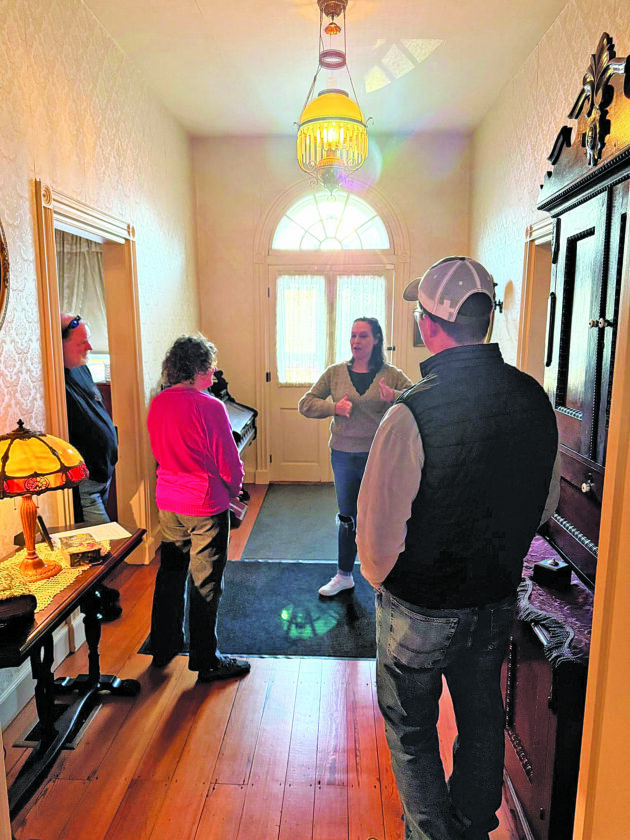
Photo courtesy of JUNIATA COUNTY HISTORICAL SOCIETY Members of the historical societies from Juniata and Perry counties stand in the foyer as they tour the Cochran-Anspach House in Millerstown.
The most memorable part of the collaborative day for Guyer was touring five Perry County historical landmarks, especially a pair of historical homes.
“My favorite part was the Fetter House in Landisburg and the Cochran-Anspach House in Millerstown because I am a sucker for a beautiful old home filled with the treasures of yesteryear,” Guyer explained.
Guyer and other historical society members also saw the Green Park School, Ludolph Church and Blue Ball Tavern. She extended a big thank you to Perry County president Jason Wilson, board member Nathan Lesh and archivist and administrator Michelle Smith-Lentz for sharing their time and knowledge with their counterparts from Juniata County.
Each of the landmarks had an equally compelling story behind it. Here are some excerpts:
Fetter House, Landisburg

Photo courtesy of JUNIATA COUNTY HISTORICAL SOCIETY A close-up of the table in the basement of the Blue Ball Tavern at Little Buffalo State Park in Newport.
The Fetter House is a lovely brick home in the heart of Landisburg, built by Henry Fetter in 1848, according to the Historical Society of Perry County’s website. Fetter was one of the merchants doing business here when Perry County was formed. He would take several wagons and proceed to Baltimore for merchandise with which he stocked his store and the balance he would sell to other merchants in Juniata and Perry counties.
On his excursions to Baltimore and Philadelphia, Fetter would pick up unemployed people who needed work and bring them back to Landisburg where they helped in the building of his house.
The interior contains beautiful millwork and paneling. When it came to building the staircase, no one was available with the necessary know-how until a down-and-out builder happened along, so the story goes.
He drew up the plans, told workers how it should be installed then went on his way. His plan was followed and the result was a charming wide stairway that goes all the way to the third floor.
In 1823, Fetter served as the second postmaster of Landisburg and in 1825 was elected county auditor. In 1831, he was a member of the board of trustees of the first school. On July 4, 1826, when the 40th anniversary of American Independence was celebrated in Landisburg, the Landisburg Artillery Corps was under the command of Fetter.
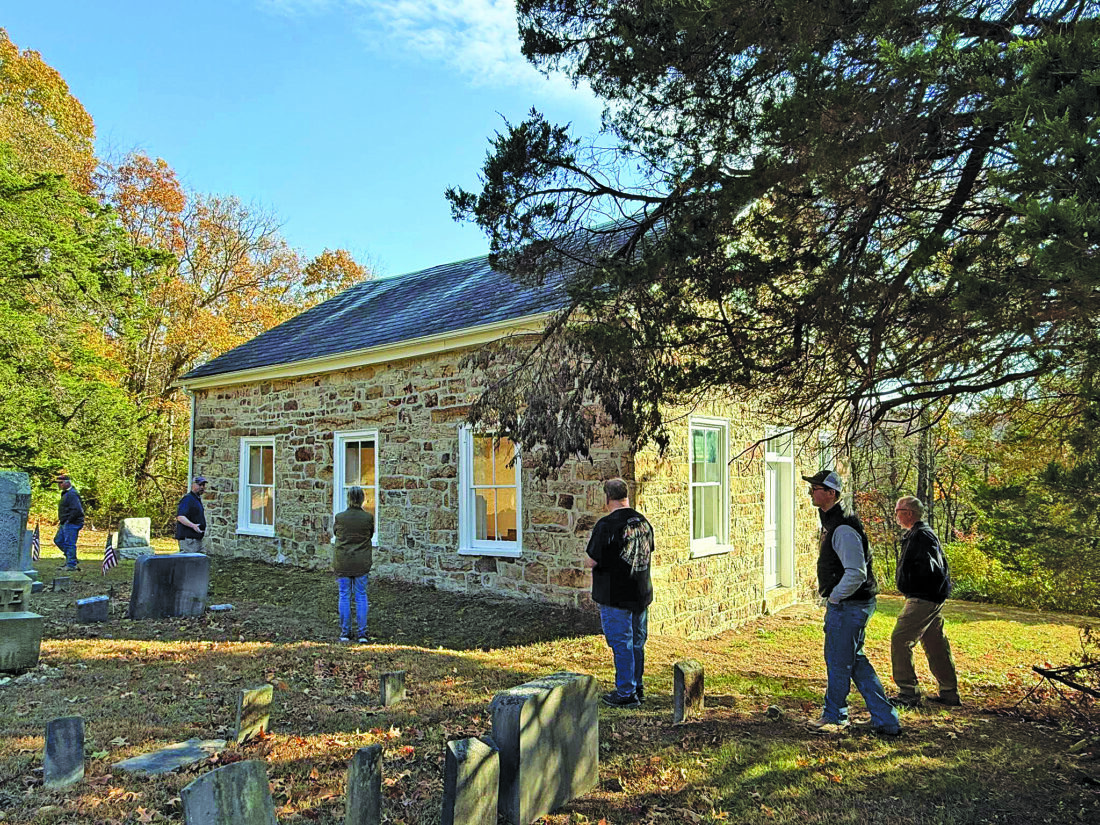
Photo courtesy of JUNIATA COUNTY HISTORICAL SOCIETY Members of the historical societies from Juniata and Perry counties are examining heavy rain damage remediation at the Ludolph Church in Elliottsburg.
Fetter was also elected captain of the Perry County Reserves of Home Militia in the 1840s. In 1857, he was elected to the Pennsylvania Senate and served a three-year term of office. It was also Fetter who donated the land on which the Trinity Reformed Church was built.
Fetter’s sword and his desk with its 13 windows in each door, signifying the 13 original colonies, and his fine old mahogany fiddle-back chairs are now in the possession of the historical society. The late Mrs. William J. Fetter, of Carlisle, donated the chairs.
The house is now owned by the historical society, having been deeded to them by Fetter’s great-great-granddaughter, Marjorie Goosens. Fetter died in December 1863 and is buried in the Landisburg Cemetery.
Cochran-Anspach House, Millerstown
The Cochran-Anspach House in Millerstown was built in 1821 by Isaiah Clark, for Thomas Cochran, one of the first settlers and a larger landholder in Millerstown. This was the third stone house that Cochran had built in town.

Photo courtesy of JUNIATA COUNTY HISTORICAL SOCIETY Jason Wilson, president of the Historical Society of Perry County, puts up the open flag at the Fetter House in Landisburg.
Cochran was born in 1776 in Londonderry, Ireland. Thomas and his three brothers purportedly owned large tracts of land, but because they were Protestant, chose to leave Ireland and come to the United States. Thomas arrived in Millerstown by 1798.
Records describe Cochran as “an elegant-looking gentleman of courteous and pleasant manners and an excellent penman.” In 1802, he married Sophia Maria Porter, of Lewistown, who was also born in Londonderry in 1776. The couple had six children together.
The first stone house constructed in Millerstown by Cochran was the present VFW house which was completed in 1801. Here Cochran kept a store and post office, as well as an inn known as the Cochran Hotel.
The first sermon preached in Millerstown was by Rev. John Hutchinson, of Mifflintown, in the barroom of the hotel in 1806. It was the beginning of the Millerstown Presbyterian Church which was later built in 1831-32 on lands donated by Thomas and Sophia Cochran.
Cochran built his second stone house, on the northeast side of the square, in 1813. He kept a store in the house beside this second house until 1834.
When Cochran died in 1846 at age 70, he had vast holdings of land in Pennsylvania and Missouri, as well as stock in a Harrisburg bank.
According to his will, Thomas Cochran bequeathed the stone dwelling in Millerstown, “all household furnishings, his riding horse and barouche, two milch cows, and the income from 200 shares of bank stock to his wife during her natural life.”
Upon her death, the furnishings were to be divided among his children and “none else.” His other holdings were willed to his surviving children. To his son, Thomas Preston Cochran, he bequeathed his farm in Pfoutz Valley, also the Daniel Hoffman farm, the stone house in Millerstown on the death of his mother, his church pew No. 56 and another pew No. 2, which was for the use of his mother and family.
Thomas Preston Cochran was born in Millerstown in 1813. His primary education was at the common schools of Millerstown which he attended until age 10. He then attended a preparatory school prior to entering Jefferson College.
Due to failing eyesight, he returned home after graduation and became a clerk in his father’s mercantile business. On his father’s retirement in 1835, Thomas Preston succeeded in running the establishment and became a successful merchant.
Later in life, Cochran disposed of the store and bought a farm in Greenwood Township where he busied himself in agriculture and mining pursuits. In the course of time, he acquired seven farms.
In 1864, he retired from actively running the mercantile business, selling all but two farms but still managing his iron ore interests.
Thomas P. married Jane Patterson, of Juniata County, in 1835. She died in 1836, leaving a son, Robert P. Cochran. In 1839, Thomas married Rebecca Black of Tuscarora Township, who died about 1884 leaving five children.
In 1886, Cochran married Hannah Maria Kauffman, a widow from Juniata County. After Thomas’ death, the property passed to Hannah, whose son Charles A., purchased it in 1916 before later passing to his daughter Anna Kauffman Anspach, wife of Irvin Anspach, a druggist from York Haven.
Their son, Irvin Kauffman, was born in 1909, and Anna and Irvin Kauffman, Sr. divorced in 1922. Kauffman and his mother lived in Harrisburg until returning to Millerstown in the 1950s. Upon his mother’s death, the property passed to Kauffman. Irvin Kauffman worked in Harrisburg for many years, but lived in the stone house in Millerstown until his death in 1981.

Photo courtesy of JUNIATA COUNTY HISTORICAL SOCIETY The bedroom at the Fetter House in Landisburg showcases two chairs from the historic Centre Presbyterian Church in nearby Loysville.

Photo courtesy of JUNIATA COUNTY HISTORICAL SOCIETY A view of the spiral staircase and all-seasons window in the Cochran-Anspach House in Millerstown.

